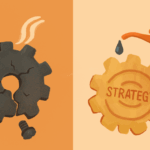Congratulations! You’ve received the exciting news that you’re able to engage a new customer relationship management (CRM) vendor. That’s big news, because the right CRM platform can make your communications with prospective students far more effective and efficient. Of course, selecting the right product is an exciting process, but also daunting; knowing where to start on your CRM selection and implementation journey can be overwhelming. Thankfully, there is a wealth of knowledge in your higher education network to help you make the right choice.
Here are some key points I’ve learned as my office has begun weighing our own CRM options, plus advice from other higher education professionals interviewed for this story, to help you choose the best vendor for your institution, school, or unit.
Assemble Your Selection and Implementation Team
Before you start researching different CRM vendors, you need to have a clear articulation of the goals of your CRM. Who needs to be at the table to have that conversation?
CRM systems offer opportunities to streamline processes and centralize data across your school or institution throughout the student life cycle, from inquiry to advancement. Your team will vary based on the scope of your CRM. Will it be focused mainly on marketing and admissions? Or do you need an enterprise-wide system managing processes and data throughout the student lifecycle?
“Make sure you have plenty of time to test and test and test again. Then you can find the majority of issues that you need to fix before you go live and students are calling and asking.” — Caitlin Getchell, University of Tulsa
Inviting key administrators from different departments is critical, including Admissions, Marketing, Student Services and IT (both school-specific and those who manage data integration from your CRM and your Student Information System (SIS)). Directors or other leaders of these departments are important stakeholders, but so too are your future CRM super users. Collecting input from those who will be working in your CRM the most can help you gain important buy-in as you’re navigating the transition between systems.
An important consideration for Kittie Pain, director of graduate admissions at Kutztown University of Pennsylvania, has been how comfortable staff feels using the product.
“Staff were the ones who chose because they were the ones who would be using it,” Pain said about a previous CRM selection at her institution.
Determine Your Needs and Wants
This is your time to dream big. In an ideal world, what would you want your CRM to accomplish? Poll your stakeholders for an internal review of your CRM needs.
“How will the CRM be used in your organization?” said Kate McConnell, director of marketing and recruitment at the Penn State Great Valley School of Graduate Professional Studies. “Will the CRM system be a full-funnel tool? If it’s going to be a full-funnel tool, what does that look like? Is there buy-in from all of the constituents to use the CRM system?”
“Some systems you have to have a person 100-percent devoted to how it’s going to function and workflow.” — Kittie Pain, Kutztown University of Pennsylvania
What external tools or programs are you currently using to supplement your CRM (e.g. marketing automation, SMS, scheduling, event management, etc.)? Your new CRM system may offer these features as well, allowing you to consolidate multiple systems into one and simplify your workflow.
Once you begin your discovery of different CRM features, you may find there are features that you may want to have that you didn’t know were possible. That’s why it’s important to update your list accordingly as you complete this next step.
Seek Insight From Your Higher Education Network
A key piece of your discovery process should be to talk with other higher education professionals about their experiences.
“Use your higher education network to find out what other people are using, what they liked, what they didn’t like and what they would recommend,” McConnell said. “Keep an open mind, do a lot of discovery and interview a lot of people before you go out and get that RFP completed.”
Pain recommends asking your colleagues:
- Has there been turnover with your support representative, or has your rep remained the same?
- What was the onboarding process like?
- How long did it take until your system was up and running?
Organize Your RFPs
Once you’ve received the RFPs back from your vendors, you will have a lot of information to sift through. At my school, we found that having the RFP responses organized in an Excel sheet where you could compare answers side-by-side was a very helpful tool (and thanks to our institution’s procurement office for creating this for us!). After going through your Excel sheet you’ll find what questions were answered, what some main differences between vendors may be and what questions you’ll want to make sure you ask during the vendor presentations.
“You have to be realistic that (the CRM) is not going to be all things to everyone.” — Shelly Quance, West Virginia University
When reviewing your RFP’s, you’ll want to note how pricing is calculated for each vendor. Is it per the annual number of submitted applications? Per student? Per user? What features come standard and are built into the price already, and which are add-ons and cost more? Are implementation costs, maintenance or training costs additional?
Questions to Ask During the Vendor Presentations
You’ve made it to the presentation stage! What are some key questions to ask the vendors?
Many CRM presentations will focus on the bells and whistles of the platform and will walk you through fully built out screens, dashboards and reports. Pain recommends asking: “What about the behind the scenes? How do we make it work?”
What can your CRM system do out of the box? What will you need to build and customize? How much logic can be built into the system?
When talking with other higher education professionals, I was told repeatedly to gather information on how much staff time will be required to launch the system. What does the implementation look like? What trainings are involved?
Then after implementation, what is required to maintain the CRM? Does your team or institution currently have the skill set to maintain the back end of your system, including data integration with other systems on your campus? Does that staffing exist across the relevant departments that will be utilizing the platform, or will you need to hire an additional team member?
“Some systems you have to have a person 100-percent devoted to how it’s going to function and workflow,” Pain said. “But a lot of us have to set it and come back.”
McConnell also recommends crafting questions about any software or reporting tools you plan to integrate with the system.
“If the vendor is telling you they can integrate with Banner or Peoplesoft, of if you’re going to use marketing automation and you need them to work with HubSpot or Pardot, tease that out and get really good references, especially those who have dealt with things you need that not everybody has,” she said.
Know Your Implementation Timeline
There are key dates you’ll need to consider when developing your CRM implementation plan.
Based on your application cycle, when does the application need to be launched in the new CRM? Also, if you have a former CRM or other vendors you will transition away from, what are the cut off dates for those contracts? When will you need to make sure all of your historical data is loaded into your new CRM or stored elsewhere before you lose access to it?
“Keep an open mind, do a lot of discovery and interview a lot of people before you go out and get that RFP completed.” — Kate McConnell, Penn State Great Valley
Will you phase in your CRM implementation by launching a few features initially and then adding in other ones later? Or will you launch all features at once?
One vendor told us their record for implementing a new CRM was just several days (gulp!). Most offices will take several months to a year to complete their implementation. If you’re able to build in a time cushion, you’ll thank yourself later.
“Give yourself plenty of time for things to go wrong and to fix them,” said Caitlin Getchell, academic advisor at the graduate school at the University of Tulsa. “When our application went live, we found issues that were not resolved and then had to backtrack and fix it. Make sure you have plenty of time to test and test and test again. Then you can find the majority of issues that you need to fix before you go live and students are calling and asking.”
Manage Expectations
West Virginia University offers more than 240 different graduate programs. When the university began transitioning to a new CRM for its graduate programs, Shelly Quance, director of graduate admissions and recruitment, and Joshua Murray, professional technologist, worked closely with two key graduate student admission councils made up of administrators and staff at the program level over recruitment, marketing and admissions.
“We did presentations with both groups and talked about why we were making the move and really tried to stress the advantages of it,” Quance said. “We had one person from every program who was aware of what was coming up, making sure they’re aware, highlighting what you can and can’t do and setting expectations beforehand.”
The team set up regular training sessions, walking staff through the basics of the CRM step by step. Murray initially hosted four to six trainings per month and continues to host one training a month.
“I ask them what kind of report do you want to build, and then I show them how to build it. What kind of communication plan do you want? We can get it set up,” Murray said.
As you communicate the benefits of your new CRM to your stakeholders, it’s important to manage expectations for other departments and for your team.
“You have to be realistic that (the CRM) is not going to be all things to everyone,” Quance said. “You need to take into consideration what works best for the majority. Try and do all that you can. If you think you’re going to in there and everyone will be completely happy, it’s not going to be that way.”
Murray and Quance also recommend centering your focus on the impact of your students when times get tough. “Whenever we reached a problem, if someone said there’s something we don’t like, we came back to, does it make it better for the student side? Is their user experience going to be easier?” Quance said.
Share Your Knowledge
Now that you have gone through the CRM selection and implementation process, you’re well equipped to help other higher education professionals as they begin researching their next CRM.
And in the meantime, best of luck with your new CRM!







